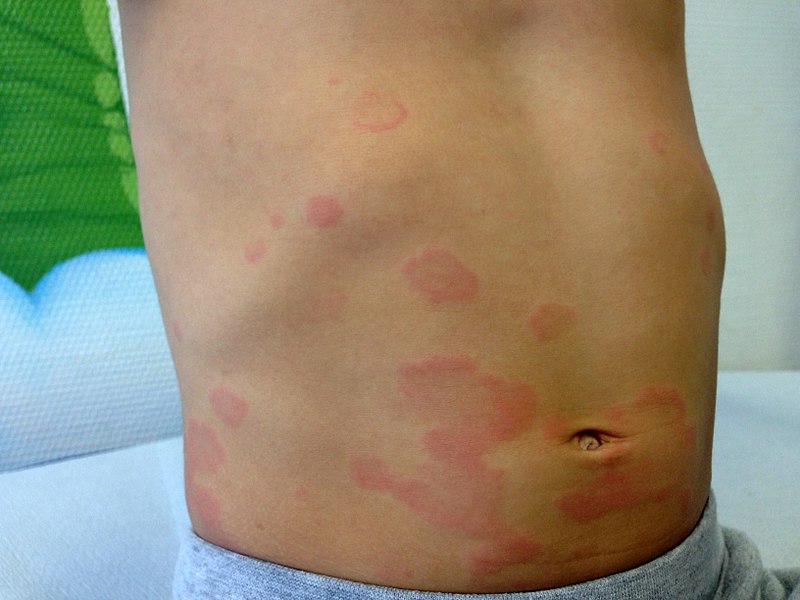
Allergy

A 6 year old boy is brought to the Emergency Department after developing an itchy red rash over his torso. He has no past medical history and is otherwise well. What is the diagnosis?
Answer:
Urticaria is a superficial swelling of the skin (epidermis and mucous membranes) that results in a red (initially with a pale centre), raised, and intensely itchy rash.Urticaria
Allergy / Dermatology
Last Updated: 13th December 2020
Urticaria is a superficial swelling of the skin (epidermis and mucous membranes) that results in a red (initially with a pale centre), raised, and intensely itchy rash.
Pathophysiology
Urticaria is a mast cell-driven disease. The release of histamine and other inflammatory mediators (such as leukotrienes and prostaglandins) from activated mast cells results in the characteristic pruritus, vascular permeability (leading to plasma leakage from the capillary into the skin), and oedema.
Causes
Acute urticaria is usually a self-limiting, one-off episode. It can occur spontaneously or in response to a trigger, typically an acute viral infection (especially in children) or an allergic reaction, for example to certain foods (e.g. nuts, shellfish, milk, eggs), insect bites/stings, latex or drugs (e.g. NSAIDs, penicillin, vaccines).
Chronic urticaria (urticaria that lasts for 6 weeks or longer, typically on most days of the week) can be spontaneous (chronic spontaneous urticaria [CSU]), autoimmune (autoimmune urticaria [AU]), or inducible (chronic inducible urticaria [CINDU]):
- CSU occurs with no known identifiable external cause. However, symptoms may be aggravated by heat, stress, certain drugs (for example NSAIDs), and infections (for example viral infection and Helicobacter pylori infection).
- AU is characterised by the presence of immunoglobulin G (IgG) autoantibodies to the high-affinity receptor for IgE (Fc epsilon R1). It accounts for about 30–50% of chronic urticaria cases and may be associated with other autoimmune conditions (such as thyroiditis).
- CINDU occurs in response to a physical stimulus.
Management in ED
- Identify and manage the underlying causes/trigger factors of urticaria, where possible.
- For people with mild urticaria with an identifiable and avoidable cause/trigger, advise that urticaria is likely to be self-limiting without treatment.
- For people with symptoms requiring treatment:
- Offer a non-sedating antihistamine (for example cetirizine, fexofenadine, or loratadine) for up to 6 weeks (use clinical judgement to determine the duration of treatment).
- If symptoms are severe, give a short course of an oral corticosteroid (for example prednisolone 40 mg daily for up to 7 days) in addition to the non-sedating oral antihistamine.
Report A Problem
Is there something wrong with this question? Let us know and we’ll fix it as soon as possible.
Loading Form...
- Biochemistry
- Blood Gases
- Haematology
| Biochemistry | Normal Value |
|---|---|
| Sodium | 135 – 145 mmol/l |
| Potassium | 3.0 – 4.5 mmol/l |
| Urea | 2.5 – 7.5 mmol/l |
| Glucose | 3.5 – 5.0 mmol/l |
| Creatinine | 35 – 135 μmol/l |
| Alanine Aminotransferase (ALT) | 5 – 35 U/l |
| Gamma-glutamyl Transferase (GGT) | < 65 U/l |
| Alkaline Phosphatase (ALP) | 30 – 135 U/l |
| Aspartate Aminotransferase (AST) | < 40 U/l |
| Total Protein | 60 – 80 g/l |
| Albumin | 35 – 50 g/l |
| Globulin | 2.4 – 3.5 g/dl |
| Amylase | < 70 U/l |
| Total Bilirubin | 3 – 17 μmol/l |
| Calcium | 2.1 – 2.5 mmol/l |
| Chloride | 95 – 105 mmol/l |
| Phosphate | 0.8 – 1.4 mmol/l |
| Haematology | Normal Value |
|---|---|
| Haemoglobin | 11.5 – 16.6 g/dl |
| White Blood Cells | 4.0 – 11.0 x 109/l |
| Platelets | 150 – 450 x 109/l |
| MCV | 80 – 96 fl |
| MCHC | 32 – 36 g/dl |
| Neutrophils | 2.0 – 7.5 x 109/l |
| Lymphocytes | 1.5 – 4.0 x 109/l |
| Monocytes | 0.3 – 1.0 x 109/l |
| Eosinophils | 0.1 – 0.5 x 109/l |
| Basophils | < 0.2 x 109/l |
| Reticulocytes | < 2% |
| Haematocrit | 0.35 – 0.49 |
| Red Cell Distribution Width | 11 – 15% |
| Blood Gases | Normal Value |
|---|---|
| pH | 7.35 – 7.45 |
| pO2 | 11 – 14 kPa |
| pCO2 | 4.5 – 6.0 kPa |
| Base Excess | -2 – +2 mmol/l |
| Bicarbonate | 24 – 30 mmol/l |
| Lactate | < 2 mmol/l |

